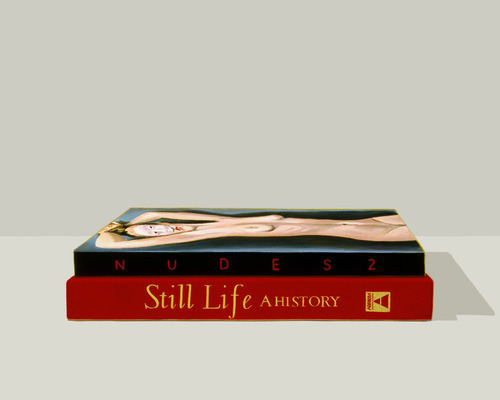
"The Still Life" has been up for about half a month and I'm very excited to report that there are
17 red dots in the showroom! Positive comments along with the sales, of course, have been very encouraging.
The spread in
American Art Collector's October 2010 issue has brought in new clients, which isn't surprising when considering the quality of the pieces featured. Click on the images below to read the full article:


As I mentioned in an earlier post, the point of "The Still Life" was to exhibit outstanding work by talented artists who "specialize" in still life. Now that the show has been up for two weeks I've had the opportunity to
really look at each piece and appreciate what each artist has brought to the table. I can't tell you how many times I've walked through the exhibition space (with the intention of going to back of the gallery) and have found my self distracted by a painting in the show.
James Neil Hollingsworth's painting,
Dumbo, is one that I frequently visit through out the day.
 James Neil Hollingsworth | Dumbo | Oil on hardboard | 24" X 24"
James Neil Hollingsworth | Dumbo | Oil on hardboard | 24" X 24" Neil's ability to differentiate the textures throughout the piece is without a doubt masterful. The piece is so impressive, in fact, that
this photograph does not do the painting justice. From the trees reflected in Dumbo's plastic skin to the creases in the the tarp covering the lower portion of the ride, the artist has treated every surface, corner, nook, and cranny with equal care and attention.
If you're in California, this painting will make your trip to the gallery worthwhile.  Shawn Kenney | Dutch Oven | Acrylic on panel | 8" X 10"
Shawn Kenney | Dutch Oven | Acrylic on panel | 8" X 10"I've also spent a lot of time examining
Shawn Kenney's work in this month's show, which is featured at the top of this post. Shawn lives in Rhode Island and attended RISD (Rhode Island School of Design) and has also worked as an illustrator, designer, and art director. There are two aspects of Shawn's paintings that attract me most - the manner in which he paints and his ability to depict light.
Although it isn't as obvious in photographs, Shawn's paintings utilize varying layers of paint to "build" and describe his subjects. Interestingly enough, areas lacking paint are equally as important as the areas with paint. This diverse range of opacity infuses each painting with a unique sense of three-dimensionality, which is further emphasized by his use of a single light source within each piece.
Both Table Setting and
Dutch Oven, for example, are illuminated by an overhead light source, allowing Shawn to focus on specific areas of his subjects. Areas that are not in the path of the light recede into darkness, creating a palpable sense of space. This dramatic combination of warm, focused light along with rich, dark background colors immediately reminds me of the "master" of painting light:
Caravaggio. Michelangelo Merisi da Caravaggio | Still Life With Fruit | c. 1605
Michelangelo Merisi da Caravaggio | Still Life With Fruit | c. 1605While Caravaggio is perhaps most famous for his religious paintings during the Counter-Reformation, we can still identify with his innovative style:
tenebrism. This term is described by the overarching use of
chiaroscuro, a style of painting that is characterized by strong contrasts between light and dark. This effect is used for both emotive and compositional purposes, and in such a way that it becomes a dominating force within the piece. Caravaggio's impact was certainly profound during his career as a painter, and his stylistic "followers" were known as the Caravaggisti. This artistic legacy persisted even after his death, as masters such as
Peter Paul Rubens, Johannes Vermeer, and Rembrandt van Rjin, utilized
chiaroscuro as a prominent stylistic element in their paintings.
Caravaggio was a household name during his life, but was almost immediately forgotten by the general European public after his death in 1610. The importance of his work was rediscovered in the 20th century, and it's exciting to know that contemporary painters are still influenced by his artistic legacy - even 400 years (exactly!) after his death.





















